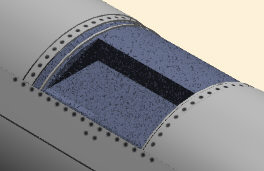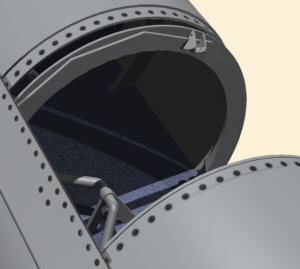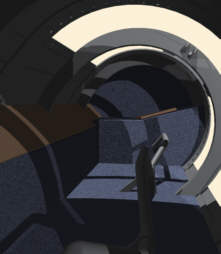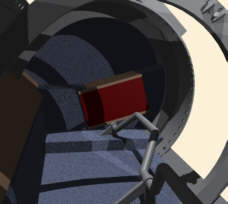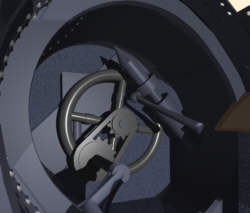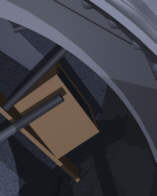|
|
rchaeology is a science with a set of standard methods and techniques and an art that draws on the experience and knowledge of the archaeologist to interpret what the process reveals. It requires careful and meticulous recording of the context of finds because in its most usual form excavation is destructive. |
|
Understanding Archaeology |
|
|
†††† It will help to summarize the
archaeological process before going on to the Hunley excavation
particulars. I can't overemphasize the importance of accurate recording
of context for all artifacts and features discovered. Every project is
a little different in detail but all do this one way or another. I'm not an archaeologist, but for well
over a decade I've participated in and contributed to numerous archaeological
projects. Iíve drawn on this more than six months of hands-on field
experience to provide the background and explanation on this page. |
|
Season I
| We had the opportunity to follow along as the archaeologists went deeper and deeper in the dense sediment filling the Hunley, but we had to make do with limited, low resolution web cam views, very few photographs, and tantalizing but terse regular news reports of findings. Having participated in many archaeological projects as a volunteer, my intent on this page is to draw on that experience to interpret the reports and try to reproduce the experience for the many interested observers. Remember this is my interpretation and subject to gross error. Likewise the speculation is mine, based on the same reports available to all. Nonetheless I hope everyone enjoys the material presented here. I certainly enjoyed the vicarious archaeology I used in creating this page and I was pleased in studying the few photos to discover several features before their formal announcement. | |
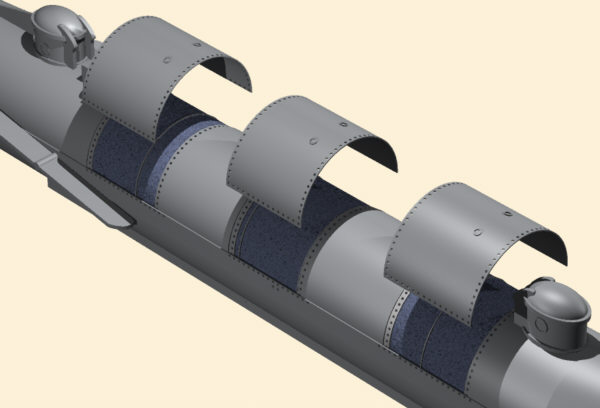
|
The schematic rendering at left, using an early version of my Hunley reconstruction, shows the locations of the three semi-cylindrical plates removed in preparation for excavation. The cabin was completely filled with sediment. |
| The rendering at right shows the crew cabin ready for excavation. Notice the narrow metal parts in the exposed hull area. These proved to be substantial elements of the internal cabin frame. |
|
|
Estimating the distance between the rings, I
found that
if there were others between the visible pairs, they would be spaced
about every two feet. My first confirmation was finding one disguised by
concretion at the aft edge of the center opening. Web cam views and released interior photos
later confirmed the
positions of the hidden interior frame components.
William Alexanderís interior drawing shows braces for the steering rods set high in the hull. The excavation of the aft ballast tank uncovered the steering lines enclosed within a tube running through the top of the tank. I expected to see something associated with the steering mechanism near the top of the cabin. A Post and Courier article indicated the archaeologists were surprised not to find it. Simon Lake's drawing, the only one to show the deadlights, places the steering lines along the sides of the cabin. Such lines could have been hidden by the concretion. A later report described tubes that might be associated with the rudder control under the crew's bench, and this was re-iterated near the end of the second excavation session. |
|
The illustration on the right shows the initial
excavation at the center panel opening. The web cams showed good excavation practice with clean level surfaces and right angles,
reflected in the graphics here. The vertical sections expose the
sediment layers for documentation and analysis.
|
|
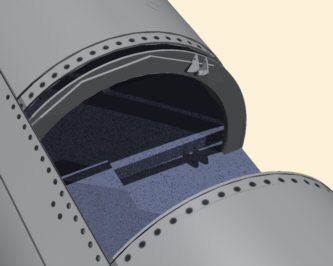
|
My excavation graphics, based on
web cam views with the hull openings partially obscured, are very much guesswork
on my part. I hope they give a flavor of the activity and progress
of the excavation. Please don't depend on them for accuracy.
The drawing at left shows my impression of the early excavation in the cabin area amidships. Remember that these are schematic simplifications. The surface of the sediment fill appears much more uniform than it really was and I've left out small features that weren't clear enough for me to interpret.
The Hunley is leaning about 45 degrees to starboard. The reconstruction leans at this angle for the excavation graphics. |
|
|
|||
| The rendering at right shows the midships area at the end of the fifth week. The crank mount visible in the illustration is much more identifiable than in the web cam view. The concretion makes the structure an almost shapeless mass and the mount is nearly invisible. Interpreting that view I thought the handle extensions angled away from the mount as shown so that the handle is narrower away from the axis. Later images confirmed this interpretation. |
|
The first of
human remains, discovered in the snorkel box part of the crew compartment at a higher level
than expected, appeared to be partly articulated, that is, with bones organized more or less as
a skeleton. Articulated remains provide more insight into the last moments
of the crew. Until then, the archaeologists had thought all the bones would be
found disorganized on or near the cabin floor.
The crewman's body was thought to have been floating near the top of the cabin while silt filtered in below. The bodies of the crew back in the cabin may have been held down by parts of the crank, or silting may have been slower, resulting in remains near the cabin bottom. Mayan burials we excavated in Belize (see below) were interred seated with drawn up knees. The skeletons collapsed into a very small area, still nearly articulated. Excavation of the Hunley crew's remains proceeded slowly. In typical archaeological practice, bones are carefully exposed using small tools with the intent of revealing as many as possible without disturbing their position. If this requires going lower in the sediment, a "plinth" or pedestal of unexcavated fill may be retained under the higher bones to support them. When excavation has proceeded as far as possible, the positions of the bones are carefully recorded with measurements, drawings, and photographs. Only then are the remains removed. Itís not particularly clear, but the third photograph on my Laguna de On page (link opens in a new window) shows such excavation of a "seated, flexed" Mayan burial. Using this careful technique helps identify individuals, especially if more than one are in close proximity. Forensic analysis may indicate something about the way the Hunley was operated, and could tell something of the circumstances of death. By the beginning of May 2000 partial remains of eight crewmen were reported uncovered more or less at their work stations. The remains of the commander were announced toward the end of the month, apparently seated at his station under the forward hatch. Early in the second session the total complement was revised to eight.
|
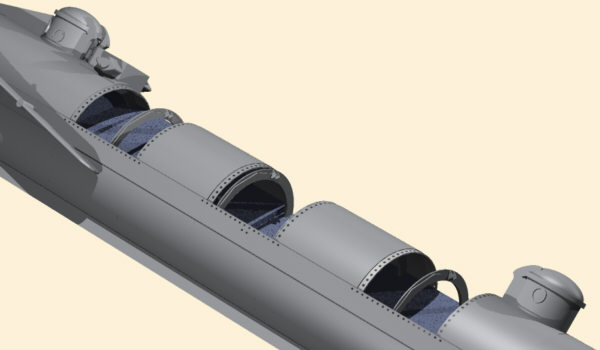
|
My interpretation of the extent of the excavation near the end of the third week is at left. As before,
the illustration is simplified, and includes speculation on my part.
Excavation proceeded slowly in the forward area because of the crewman's skeleton and the concreted mechanics associated with the diving planes and an unexpected air pump. |
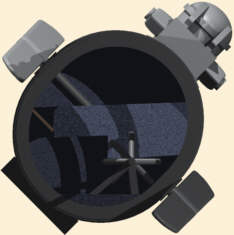
| The illustration at left,
a cross-section looking forward, shows the fill remaining in several areas
as it may have appeared during the third week. The extent of excavation varies from area to
area. The pictures above show that it is relatively easy to
excavate the open areas, but more difficult under the plates between the
openings. An important unexcavated area was under the snorkel
box and the forward hatch, Lt. Dixon's station.
There were things besides artifacts I looked for as excavation continued. The early accounts say the hull was made by cutting a cylindrical steam boiler in half lengthwise and adding expansion strakes on the sides to increase the height. If this is accurate, I expected the rivet back plates to be semi-cylindrical, just like hull plates, and not to extend the full circumference. At least one photo seemed to show the latter. |
|
This rendering provides an interior view looking forward
from the aft opening. The released interior photos showed heavy concretion
masking details I've speculated here. The wooden bench is visible close to the sediment surface on the left side of the image.
I presented it as a single board in the graphic, but wondered if there were individual
seats. The bench appeared to be inclined about 45o, making it
actually horizontal if the Hunley were on an even keel. Excavating in sections to expose vertical profiles as shown here is standard archaeological practice. |
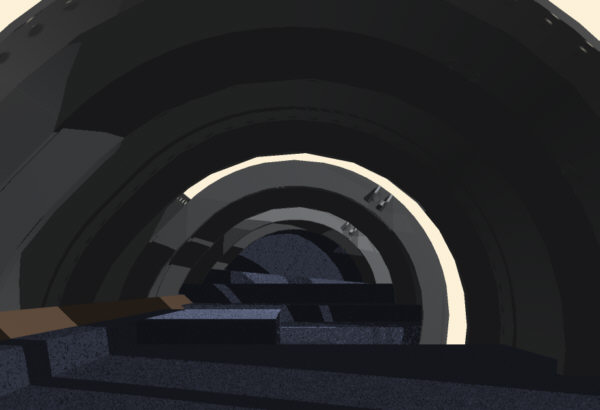
|
| Archaeologist Mike Scafuri found the first crew artifacts, two very well-preserved buttons, on the bench in the opening amidships. |
Here's one of the things I
find so exciting about archaeology: Using manufacturer's marks on the backs of the buttons, the Post and Courier identified the buttons as possibly coming from the coat of crewman Cpl. C.F. Carlson. One can never be certain, but imagine the science, and art, that might tell us where an individual sat on that historic mission 137 years ago. You can read the newspaper report via the Post and Courier link on my main Hunley page. |
|
The later discovery of a Union soldier's identification tag caused a stir, and showed the close relationship between archaeology and history. Searching historical records uncovered a possible link between this soldier and the Hunley, but didn't resolve the questions raised by the find. |
| |
|
Removal of fill aft uncovered what seem to be controls for the ballast tank in the area under the aft hatch. Alexander's drawings show the sea-cock for filling the aft tank centered on the port side in this area. Chapman's painting shows what could be the inlet for this valve, maybe a third of the way up the hull in about the same place. The hatches are attached to the hull where it begins to taper, additions to the original cylindrical boiler parts. The aft panel opening adjoins its tapered section, but the forward opening is separated from its section by the panel with the snorkel box. Heavy interior concretion, not illustrated at all above, made it difficult to reach the area under the hatch and the forward bulkhead. As excavation went deeper it proceeded more slowly. The clay fill was more densely packed, and discovery of remains and artifacts necessitated delays for very important context recording and documentation. Uncovering of very fragile fabric artifacts especially slowed the process. | ||
| There
wasn't much
photographic information available late in the excavation and although the web
cams
provided tantalizing views, they showed only a very limited area. The
textual reports
though were rich and I've tried to address a little of that in my
interpretation. Excavation had progressed much less in the forward area, because of
many features, artifacts and remains. A large bellows device, apparently associated with the snorkel, further slowed access to the forward hatch area.
|
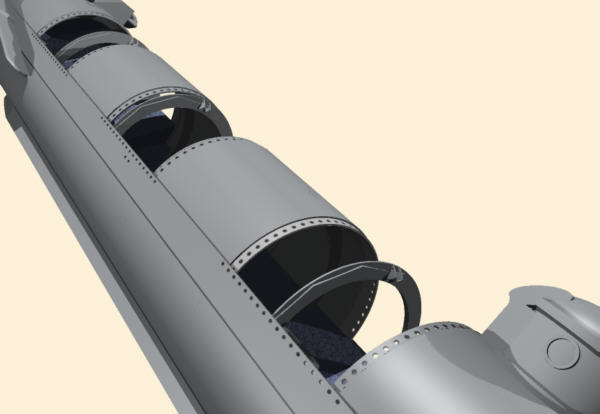 |
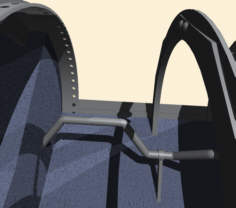 |
These two renderings approximate photos showing the most forward part of the crank. Notice the considerable fill remaining in the next forward section under the snorkel box, in part because of the bellows discovered there. |
|
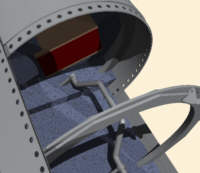 |
These
speculative renderings show the same area with the fill taken down along
the edge of the bellows to the point where it became clear that the crank
does not extend to that section. I've shown a rectangular bellows,
although two boards connected at a pivot is more likely. Since the descriptions are too general to
place anything, I've left out other parts of the mechanism. At first I thought the bellows might be foot pumped but now I think hand operation is more likely. See my reconstruction page for more speculation about the bellows. |
|
| After attempting to remove the bellows, a next to impossible task if my speculation about its attachment were half true, the Hunley team returned to one of their earlier plans for accessing the forward area and removed the plate with the snorkel box. Having excavated the area some, it must have been easier to disconnect the snorkel mechanics. |
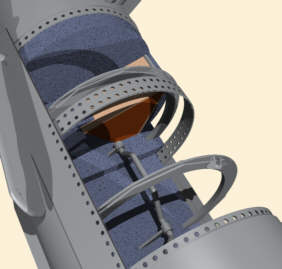 |
The highly speculative rendering at left show the forward cabin after removal
of the plate. The low resolution overall web cam view showed the
rivet plate between the sections, the adjacent frame ring about where I
expected it, and considerable fill remaining at the forward end. The
bellows was very difficult to make out in the view. The work area cam provided a field of view similar to this, but cut off at the bottom. The interior it showed soon after removal of the plate was much more confused than my rendering. More fill had been removed under the forward hatch plate, revealing a jumble on the port side. The dive plane axle was visible just aft of that. The bellows apparatus was another difficult-to-interpret jumble with what appeared to be some sort of structure just forward of it. The frame ring was obvious just forward of the rivet plate, but the next ring, still in the fill in the graphics above, was not obvious. Based on the number of rivet holes, the removed plate turned out to be larger than I'd estimated, necessitating changes to my reconstruction. |
| The rendering at right, which approximates the photo taken when archaeologist Maria Jacobson discovered Lt. Dixon's gold coin, presents my guess of the extent of excavation when work was suspended for the summer. The axle joining the dive planes runs from top to bottom on the right, with what I thought was the control lever attached near the top and projecting into the commander's station. The image includes an approximation of what I saw as the ballast tank pump, with its handle going back over the axle and just touching the last crank mount. The last crank handle is visible on the left. Except for under the bench, the second crew station is shown clear of fill, but I've left some in the forward stations. | 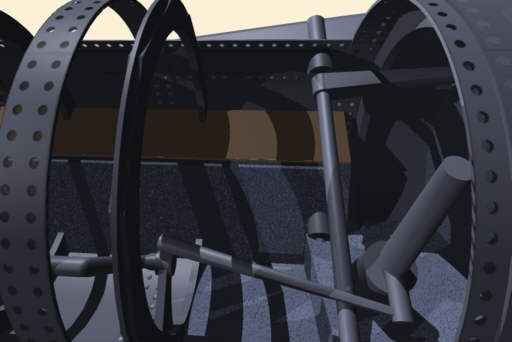 |
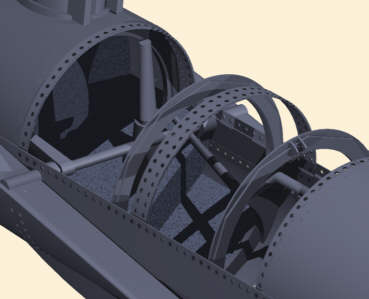 |
The speculative pump top and pump handle are clearly visible in the web cam view, approximated at left. The diving plane axle is also visible but my placement of the control handle remained speculative. This position was confirmed in later photos and reports. I included a frame ring forward of the pump, although it wasn't clear it actually exists. Later photos appear to show a ring that is much smaller on top than on the sides, perhaps to facilitate crew movement. |
|
The rendering below gives a view I was waiting for. I placed the camera just under the hull plate and pointed it forward. |
|
The bench, with fill remaining below it, is on the left. The dive
plane axle runs diagonally across the cabin forward, with the speculative
ballast tank pump forward of it on the starboard side. The forward
bulkhead is hidden by fill in the front part of the commander's
station. Again, I've guessed there is some fill remaining on the
floor of the forward stations. (This camera view was provided to lab visitors during the summer, but never released to the public.) |
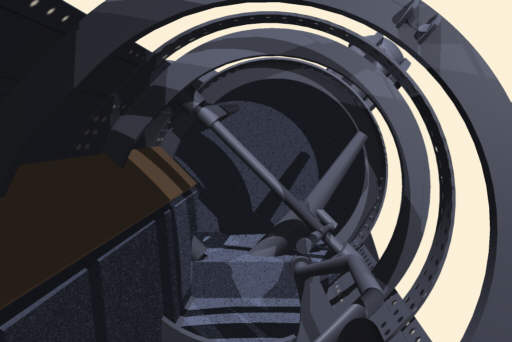 |
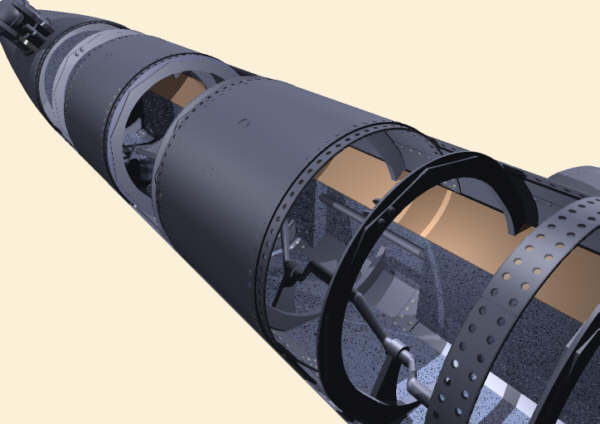 |
The view at left approximates an underwater photo published by the Post and Courier in June 2001. It shows a possible control rod or air pipe under the bench, but not some of the large featureless concretion masses also visible in the photo. The sediment remaining on the floor is also speculative. |
 |
Excavation was suspended for the summer before all the fill was removed.
According to the report, a foot of fill remained against the fore and aft
bulkheads, although this was underestimated. The schematic at left, from the port side, shows this and
the fill
left under the crew's bench, although it's likely some of that had been
removed. The report also said the forward hatch had not been
excavated. The inset shows how fill could remain supported by
the side of the hatch, even if half of the commander's station has been
excavated. (The web cam showed a new brace under the hatch, probably
to support the sediment above.) The schematic shows fill on the floor of the forward
stations, although this may have been removed in uncovering the crew's
remains. The reports did not say all remains were recovered and my speculation that some remained in the commander's station was later confirmed. |
| Why retain these foot-thick plugs of sediment at the ends of the sub? One reason might have been to protect the controls on or near the bulkheads. Alexander's drawing shows ballast tank fill valves on both bulkheads, and a manometer, compass, and steering control at the forward. Leaving them in the protective sediment over the summer would prevent deterioration. | |
|
The Friends of the Hunley reported also that a geologist will
study the sediment stratification at both ends of the cabin. As sand
and other marine material filtered into hull over time, it settled to the
bottom in layers that remain today. The geologist would look for
physical, chemical, and micro-content variations in the fill to identify
layers, as illustrated in the exaggerated image at right. These
layers represent a time sequence with the oldest layers at the
bottom. They might even show if the Hunley listed slowly
after it sank, or settled that way immediately. The sequence mapped on the forward
plug can be compared with that on the aft and with similar information
recorded as sediment was removed over the months of excavation.
Eventually, a three-dimensional map can be produced, showing just how the
hull filled. (See the Sediment Analysis note below
for more information.) |
|
| The time sequence was centuries rather than decades, but see my photo of geo-chronologist Tom Stafford performing just such mapping in an eight-foot deep trench in Belize on my Laguna de On page (link opens in a new window). |
Season II
| The project resumed with about of week of x-raying in October 2001. By mid-October new excavation was revealing more of the Hunley. | |
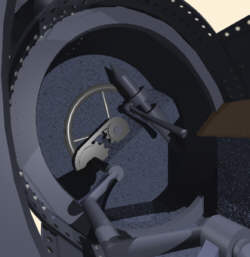 |
The impression at left
shows the rear hatch area at the end of the first week of the new
excavation season. The features appear much clearer in the rendering
than they actually did on the submarine. In reality many details
were obscured by heavy concretion and the difference between the fill and the
features was less obvious. Much of what is depicted here is my own
interpretation. Reports describe a flywheel and what is
probably a chain connecting a gear on the crankshaft with one on the
propeller shaft. The rendering includes a highly speculative
interpretation of the aft ballast tank pump.
Bench support brackets and attachment fixtures for the keel ballast were reported at the end of the second week, but no photos were available. The bench was revealed to have three sections. |
| By the end of the third week of excavation the archaeologists reached the aft bulkhead, which was further aft and surprisingly shorter than expected. Numerous details of the construction were uncovered including pump and valve connections but few photos were available to aid my interpretation. A rectangular mechanism that may be associated with the steering control was not reported but appeared in one of the photos. It's depicted at right just behind the flywheel. |
|
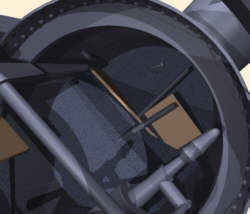 |
After four
weeks, nearly the entire crew section was excavated. Recent confusion
about the remains uncovered was resolved: the Hunley held a crew of
eight, including the captain. Since there are seven cranking stations,
this raised doubts in my mind about the importance of the air pump and
snorkel. Lacking dependable information about the location and
distribution of the remains, I'm now inclined to accept historical accounts
that the snorkel was ineffective and not used. |
|
The wooden box containing the compass was x-rayed during the fifth week
and efforts to remove it began. The box sat on a wood shelf that
appeared to be attached to the forward bulkhead. Press reports said
the compass had come loose within the box and was concreted to the
hull. A photo provided the press suggested the compass body might
have been
lying on its side fore and aft in the box. This position could have
resulted if the compass floated free when the cabin filled with
water. I wondered if a steep dive might have caused it. The box
is of tongue and groove construction, with a slide-off top that is not
attached. The most recent reports made no mention of the other controls in the forward section and my crude rendering at right remained highly speculative. I have speculated that the cylindrical object rendered as metal just left of the box could be a mounting bracket, or a soft iron compass corrector to compensate for the iron hull, or might even be a candle (but see below for its actual function). |
|
|
The compass,
or at least its box, was removed during the sixth week, but more
importantly, the most recent reports finally described the side-to-side
tiller pictured above. It is connected to mechanics of some sort under
the bench and eventually to a mechanism that runs over the aft bulkhead.
Excavation of the cabin was reported complete about this time and, as the
archaeologists and conservators turned to artifacts and remains that had
been block-lifted, that is removed within blocks of sediment, further
reports from the Friends unfortunately ceased.
During the early 2002 excavation hiatus the underwater web cam, mounted in
the cabin looking forward from about the fifth crew position, gave a
reasonably unobstructed, if murky, view of the forward hatch area.
Close examination of the view suggested two things to me: |
|
o |
The feature in the center of the shelf, next to the compass, extends to the cabin ceiling, making it a foot and a half long. In a March presentation at the Smithsonian in Washington DC, Maria Jacobsen revealed that this is actually part of the hatch latching mechanism, indicating that the forward hatch was not latched, perhaps an interesting clue in solving the mystery of the Hunley's loss. |
| o | The top part of the tiller was clearly visible in the web cam view. Much less visible was the lower part, possibly coming close to the end of the steering rod on the floor, which was clearly visible. The rod is not actually under the bench, but appears to be angled closer to the centerline forward. The view is too dark to draw a definite conclusion, but the tiller may be connected directly to the rod rather than by a more complex crank linkage. |
Sediment Analysis Some of Maria Jacobsen's remarks at the Smithsonian seminar provide at qualitative view of the sediment analysis mentioned above. The lower part of the cabin was filled with very fine sediment that was deeper at the forward end. Although all the remains were in very good condition, Lt. Dixon's were especially well preserved, indicating he was covered by the protective sediment sooner. The fine sediment indicates there was no large breach in the hull, but that the water came in relatively slowly through an opening or openings small enough to keep coarse material out. The upper layers on the other hand consisted of much coarser sediment, including relatively large shells. This material would have entered the hull through larger openings, like the three we find in the hull today. This information indicates there was no catastrophic damage to the hull during or following the attack on the Housatonic and suggests she did not sink outright, although she may have suffered from slow leaks. The major hull damage seen on the Hunley occurred some time after the historical events and was not a consequence of the attack or pertinent to her loss. Considered with the locations and attitudes of the crew remains, this information tends to support a loss-of-oxygen scenario over outright drowning, although the co-mingling of remains near the pump stations is evidence for leaking. You can read a summary of the Hunley sediment analysis on the Geological Society of America web site at this link. |
|
Artifacts and Archaeology The popular impression of archaeology, embodied in the Indiana Jones character, is that its purpose is the recovery of artifacts. In reality, the context of the artifacts is much more important than the artifacts themselves, because that's what reveals the history. The regular reports about the excavation list the discovery of artifacts and mention the difficulty of recovery, but don't relate the importance of the archaeological context. The discovery of a pipe in the Hunley is interesting, but the discovery of a particular individual's pipe, carried in the pocket of his jacket, is significant in telling us about that man. What the reports don't tell us is the archaeologists' careful recording of this context to eventually compose this story. That's why it's taken months of excavation to get this far. Read between the lines and learn about archaeology. |
|
Interpreting finds in
their historical context is an important part of archaeology. This often
requires going to historical records, other field reports, or museum
collections. Sometimes identification is made in unexpected ways.
Is this
the what the famous Hunley signal lantern looked like? |
Later Activity
| After a considerable hiatus a fifth hull plate was removed in July 2003. A quarter panel was removed from the forward tank for conservation study and to provide access to the tank for sediment excavation. The plate is part of a panel that was previously though to be a single piece. The only other access, a small hole on the starboard side and the opening over the cabin bulkhead, is insufficient for this task. | 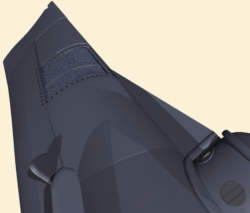 |
|
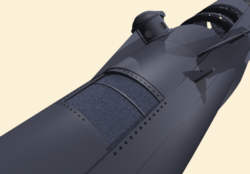 |
A similar situation exists in the aft tank. Although there is a large hole on the starboard side of the tank, it is far aft, limiting access to the remaining sediment. Access over the bulkhead is limited by the steering linkage, the propeller flywheel, and the other mechanisms in that location. | |
| I included a speculative frame
stiffener in the above renderings. A Post and Courier photo
shows a stiffening ring an inch or two forward of the aft edge of the
opening in the forward ballast tank. There appears to be one in
the same position in the aft tank. There is a small possibility that the crew tossed objects into the tanks over the bulkheads or that the builders left a tool or two behind. The expectation was that only more ballast weights will be found (but see below), but the sediment layers may provide further clues to the loss of the submarine. |
 |
| The graphic above shows the
approximate areas of remaining fill in dark gray. The current hull
openings are shown cross-hatched. My guess at the extent of the
first two weeks of excavation is shown in lighter gray. In the
forward tank excavation may have reached further back toward the cabin
than I've shown.
Week 1
Just small enough to pass over the top of the bulkhead, the cask might have been dropped in by accident. It's also possible it was left behind during construction. If it were a float, it seems to me it would have been found higher up in the tank and would contain similar sediment to the tank. It's not likely a cask of hooch would have been placed in the tank, but it might have been wedged at the top of the bulkhead and fallen in. We could better speculate on the chamber pot possibility if we knew a little more about the cask. If a chamber pot were used, it's possible it was dumped out in the tank and could have been accidentally dropped. It seems to me less likely that this would have been a task for the commander, though, unless he had his own. Of course the aft bulkhead is less accessible because of the propulsion and other machinery located there. If the cask were dropped in the tank, there's no reason to suppose this occurred on the final mission. Once in there it would be difficult to retrieve. Week 2 Week
3 Week
4 Later Finally, the next phase of activities was announced. After additional laser mapping and x-ray documentation of the interior, the internal mechanics will be removed for separate conservation. The bench, crank, pumps, and ballast ingots were specifically listed in the Post and Courier report. |
Even Later Activity
| From the beginning of this project
archaeology and conservation have been applied together. The
archaeologists excavated during the day. Every night the Hunley
was kept in a preserving underwater environment. As features were
exposed, the conservators came in to treat and protect them. After
the removal of the sediment, conservation has become the dominant process,
but archaeological recording techniques are still applied as concretion is
removed since artifacts and features are exposed during the removal.
In
January 2005 the Friends announced the removal of the crew's
bench. At the time of the announcement the two forward sections had
already been removed and work was proceeding on the final section.
They revealed the total length as 17.85 feet, clearly converted from the
metric used for documentation throughout the project, and described the forward
section as six and a half feet long. My reconstruction had that
section correct but my total length was about 20 inches too short.
The report mentions the aft section is "mounted within submarine's
aft pump mechanisms" so it is likely I have that one too
short. I had used a ĺ-inch thickness rather than the announced
three centimeters, a rather careless mistake on my part. Standard
wood measurements (2x4, 1x12, etc.) have decreased in actual size over the
years, but I recall that the studs in my not so very old house in
Connecticut measured a full two by thee inches. The report also
described the the bench as still 50% covered in lead-based paint, a fact
that has been obvious in the numerous bench photos previously released. In mid-February
2005
the scientists showed the removed bench to the press and revealed it is
"heavy ... conifer, pine-related wood" and had been painted several times with a white,
oil-based paint. This supports my reconstruction concept of a white
interior. The scientists stated that the condition of the bench
indicated it had been in an oxygen-free environment and suggested that the
cabin did not fill with water early on. Associated Press photos
showed what appeared to be each end of the center section. The aft
end showed a long piece split off the back of the bench that had been
apparent in earlier published material. The forward end revealed
three metal fasteners - probably nuts - embedded in the wood a half-inch
or less from the end. The Post and Courier revealed the presence
of a joining block here. Additional low resolution photos published
later in the Friends' Blue Light newsletter don't provide
much additional information, but show that concretion was removed from the
stiffener rings where they pass through notches in the bench.
Earlier photos show this concretion spreading out some over the
wood. I considered and ultimately rejected this as evidence of bracket
locations. The latest photos confirm my identification of the center
section above, but offer no new clues about the mounting mechanics. |
|
| By mid-April 2005 the
depth gauge had been removed. The
Friends reported that the glass tube must have broken during the last
mission or shortly thereafter since a pool of mercury was found on the
cabin floor beneath the sediment. Although the dangers of mercury
were not as widely understood then as they are today, it's unlikely that
the puddle would have been left there if the break had occurred earlier.
The apparatus was reported to be three feet high and mounted on the port
side of the cabin at Dixon's position. We've known since the
Smithsonian presentation that the gauge inlet is on the port side just
above the ballast tank valve inlet but mounting the gauge along the side
seemed strange to me. The hull side is curved and the apparatus would
need to be curved or bent to be out of the way, especially since the dive
plane control lever moves through that area.
At the time I speculated that the report included a
misunderstanding and that only the inlet was on the port side.
Dixon's shelf has a cutout in its forward edge next to the tank bulkhead
and photos show some vertical lines in the bulkhead above and below the
shelf. Subsequent publication of an x-ray of the gauge and close examination of
earlier photos verified my speculation that this was a better position for the
gauge.
(Read more about this on my reconstruction
page.) The
shelf must have been removed first to permit removal of the gauge. The speculative graphic at right shows the gauge approximately as it looked upon removal. The concretion is probably more extensive than I've shown and the inlet tube may extend further to the left. |
|
| The gauge announcement was made while I was pondering the possible effects of the torpedo detonation, probably a pressure surge on the order of 950 psi, on the Hunley leading to a Eureka! moment. It appears from what we have heard to date that the hull suffered little damage from the explosion, but the thin glass tubing, less than ľ" diameter, subjected to the same pressure as outside the hull may have burst. | |
|
A
week later, the Friends announced the discovery of an oddly marked
copper plate on the floor of Dixon's station. Traces of zinc on the
plate, a piece of copper wire found nearby, and what was described as a
spool of wire hanging in the forward ballast tank led to speculation that
this might be part of an electrical detonation system for the
torpedo. The spool is actually a loose coil that was hanging in the
tank on the inlet pipe. A photo taken in 2003 during the forward
tank excavation but just published shows a coil of approximately one-foot
loops. To end 2005 the Friends announced removal of the glass from the forward tower viewports. No official photo was released, but Brian Hicks' Post and Courier article included several. The clearly pictured port-side viewport closely matches details in an x-ray displayed in the Warren Lasch Conservation center. Externally, the viewport has an outside diameter of nearly four inches with an opening of about 2 and one-third inches. The port is affixed to the tower with four rivets or bolts. In
May 2006 The Blue Light reported the discovery of rubber disks
blacking out ports in the forward hatch tower. The plugs had string
lanyards for easy removal or to keep them from being misplaced when not in
the ports. Some of these were found in place, but at least one was
discovered on the floor of the submarine. The report is incomplete
providing a count only for the forward hatch, but these must have been
standard for both the forward and aft hatches. To date no photos
have been published of the porthole work on the aft hatch. In
Jul 2006 the Friends announced the discovery of parts of the forward
hatch latch mechanism apparently stored on the floor on the left side of
Dixon's station (as reported by Brian Hicks in the Post and Courier).
The mechanism appears similar to the latched aft hatch mechanism, a flat, rectangular
bar with a hole threaded on a rod attached to the hatch lid. The
various reports are not consistent, but we can infer from these and
earlier reporting (see above) that two major parts of the forward latch
were found behind the rudder linkage and ballast tank interconnect
pipe. As always in archaeology, where artifacts are found is as
important as the artifacts themselves. Since the Hunley lay
on the bottom listed about 45 degrees to starboard and the linkage and
pipe run on the port side, it is unlikely that the latch could have fallen
to that position, for example, as a result of the later event that made a
hole in the hatch coaming. The dive plane lever with its large
counterweight is above the position, making it unlikely the mechanism fell
there even if the sub was upright. The most likely implication is
that Dixon stowed the latch there. Conservators removed the rear hatch cover in mid-September 2006. Removal was necessary because the cover deadlight glass could not be removed from outside and the latch mechanism prevented access from inside the sub. Upon removal the conservators found what may be a small valve in the lid about halfway between the forward edge and the deadlight. Removal of the hatch cover exposed the top of the hatch tower, revealing the actual thickness of the original metal. Very nice photos published in the Charleston Post and Courier show the actual thickness to be a very thin 1 to 2 centimeters. The interior concretion is twice as thick, helping to explain the lack of visible detail. The concreted latch mechanism is visible in two photos. A narrow vertical rod with a knob-like tip rises near-center in the hatch tower from a larger crossbar fastened side-to-side below the tower. The smaller hatch-top photo reveals a similar knob near the center of the lid. What may be the end of the suspected valve handle is just discernable. Over
the years there has been much speculation about what caused the large
hole in the Hunleyís aft ballast tank.
In mid-November 2006 Brian Hicks reported in the Post and
Courier that this and other damage could have been caused by strong
water currents sandblasting the iron.
The starboard hinge on the aft hatch cover is noticeably worn as
are many of the view port mounting rings.
The scientists believe itís possible that even the now-familiar
curve of the Hunleyís bow is a result of this sand-laden current
scouring. The damage is mostly
on the starboard side, probably because of the extreme list to this side.
A swift current moving through here could have been accelerated by
the Venturi
effect and whipped up additional
sand. In
January 2007 conservators
opened (rather than removed) the forward hatch. The intent was to
expose the rubber seal in the lid so it could be removed. This must be done
before the chemical corrosion treatment of the metal can begin.
However, some of the concretion around the hole in the forward
hatch tower is attached to the lid and covers the seal. It is possible that the
damage occurred any time from the night of the submarine's loss to many
years later. The hole could be the result of a violent impact or the
result of continuous wear in the sand-laden current. All
the concretion around the hole needs to be carefully analyzed to place
this damage in the Hunley timeline. Removal of the seal will
be delayed until this study is complete. At
the end of August 2007, the Friends of the Hunley announced the
discovery of several small pieces of cast iron on the cabin floor beneath
the forward hatch tower. One of these pieces is curved and, as
demonstrated on the History Channel program Digging for the Truth
in September, is close to the curvature of the port glass of the
starboard-side view port. This raises the possibility that it is
part of the missing port-side view port. In
January 2008 conservators removed the aft pump from the Hunley.
This is part of the continuing process of separating materials that would
be damaged by the chemical treatment that will stabilize and preserve the
iron hull. To gain access to the bolts that attached the pump to the
hull, in December they had removed the approximately 500-pound aft-most
keel weight. This is one of four that were permanently attached as
opposed to three that were designed to be dropped with releases in the
cabin. Brian Hicks revealed that the top of the weight was curved
fit snuggly to the hull but "there was a little wood between the
block and the sub". Conservators removed the
forward pump from the Hunley in late May 2008.
As with the aft pump it was first necessary to remove the fore-most
ballast block to gain access to the four lower attachment bolts.
A photo released by the Friends of the Hunley shows how closely the
block is fit to the hull. There
is a rectangular groove running half way down the top of the block to
accommodate the joining strip on the bottom of the tapered portion of the
hull. In
early 2015 the Friends released photos and videos showing the Hunley's
exterior completely cleaned of concretion,
revealing new details of its construction. The first thing I noticed
is that seams on the lower hull in the tapered sections of the hull don't
match up with those on the upper hull, evidence of the use of existing
metal plating in the Hunley's construction. The photos I've
seen don't show the central hull in sufficient detail, but I suspect the
seams there match. Some interior photos showing the rivet plates
support this. The Fall 2016 Blue Light (Vol. 48) includes information about the depth gauge as well as post-conservation photos. The four-page article reports a wood plug "jammed into" the glass coupling. This could only be done if the glass tube, indicated to be some 30 inches long, was removed. The article speculates plug was intended to disable the gauge, but this seems unlikely to me because the remains of the glass tube as well as some mercury was found on the floor of Dixon's station. To me it's more likely that the glass broke or came loose and Dixon used a piece of wood to staunch the flow of mercury, perhaps fearing water could follow. As the glass remained in the cabin, we might speculate this happened during the final mission, but it's not certain that the cabin would have be tidied between missions, removing the likely broken glass. |
|
I will update this page when significant additional information is released. |
|
View my Hunley 3D reconstruction here. |
 |
This page and its contents
© Copyright 2001, 2002, 2003, 2005, 2006, 2007, 2008, 2016 Michael & Karen Crisafulli. |

